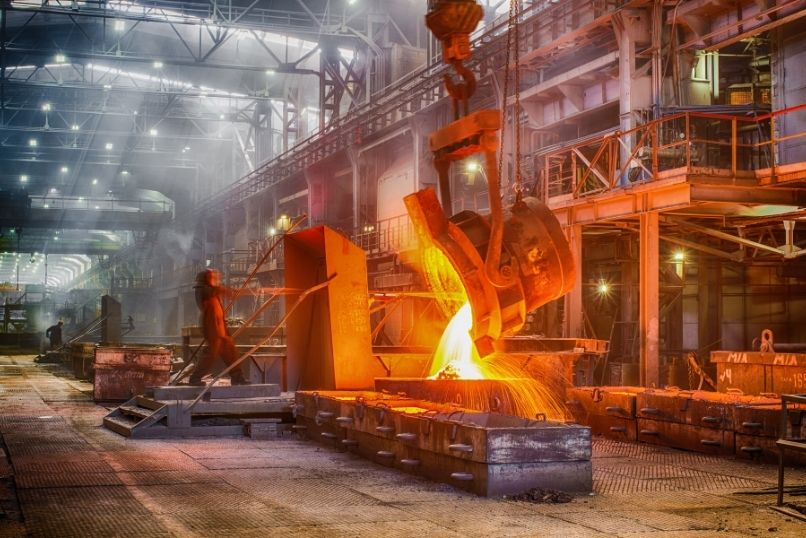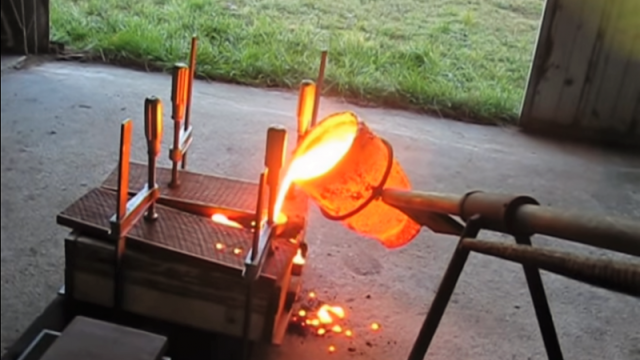How technological advancements shape the Aluminum Foundry sector
Wiki Article
Exploring the Core Solutions Used by a Metal Shop: An Extensive Summary
The solutions offered by a metal factory play a vital duty in numerous sectors. From metal spreading processes to mold and mildew construction, each element is created to ensure precision and efficiency. Quality control actions additionally enhance the dependability of the products generated. Recognizing these core services can reveal just how they accommodate particular industrial demands. What subtleties in these offerings add to their effectiveness and flexibility?Understanding Metal Casting Procedures
Metal casting is a centuries-old strategy, comprehending its processes stays essential for contemporary manufacturing. Steel casting entails pouring molten metal right into a pre-formed mold and mildew, permitting it to strengthen into the wanted form. This process encompasses several essential phases, consisting of thawing the metal, preparing the mold, pouring, and air conditioning.Different casting methods, such as sand casting, die spreading, and financial investment casting, deal with diverse production needs and product homes. Each method uses unique benefits, such as expense effectiveness or accuracy, making them ideal for diverse applications.

Pattern Making Strategies
Pattern production techniques play an important function in the metal shop procedure, functioning as the structure for producing precise castings. Typical methods have been enhanced by modern-day electronic methods, which enhance precision and efficiency. Understanding both techniques is crucial for optimizing manufacturing and fulfilling the needs of various applications.Conventional Pattern Making
When creating metal castings, conventional pattern making functions as a fundamental strategy that has actually stood the test of time. This technique involves crafting a physical design, or pattern, which duplicates the preferred form of the last spreading. Commonly made from plastic, metal, or wood, these patterns are made to make up elements like contraction and mold release. Artisans knowledgeable in this craft utilize numerous methods, consisting of split patterns and core prints, to ensure exact molding. The procedure typically needs meticulous interest to information, as the pattern directly affects the top quality and accuracy of the end product. Standard pattern making not only personifies workmanship but also ensures the dependability and uniformity essential in the steel spreading sector.Modern Digital Techniques
The development of pattern production has embraced modern-day digital techniques, greatly enhancing accuracy and efficiency in the steel spreading procedure. Computer-aided design (CAD) software program allows designers to create complex patterns with specific specifications, lowering human mistake and material waste. Additive manufacturing, or 3D printing, permits fast prototyping of patterns, promoting fast changes and iterations. These electronic techniques support complex geometries that standard strategies may battle to replicate. In addition, incorporated electronic workflows simplify interaction in between design and manufacturing teams, guaranteeing a cohesive procedure from concept to spreading. Inevitably, the adoption of modern electronic strategies in pattern making not only enhances production timelines however also elevates the quality of the final steel elements, placing factories at the leading edge of innovation in the market.Mold Design and Manufacture
Mold design and fabrication are important parts in the metal factory procedure, affecting both the top quality and precision of spreadings. Numerous kinds of molds, including sand, financial investment, and ceramic, serve different applications and materials. The layout process involves numerous key steps that assure mold and mildews are customized to meet particular production demands.Kinds of Molds
In the domain of metal factories, numerous types of molds play a necessary function in forming the end products. The most common kinds consist of sand molds, which are flexible and cost-efficient, ideal for complicated forms. Shell molds, known for their smooth surface areas, give high precision and are commonly utilized for smaller manufacturing runs. Investment mold and mildews, or lost-wax molds, are utilized for elaborate designs, enabling for high detail and excellent surface area coating. Irreversible mold and mildews, made from steel, are resilient and suitable for high-volume manufacturing, creating consistent results. Finally, ceramic mold and mildews are used for specialized applications, particularly in casting high-temperature alloys. Each mold type is picked based upon the particular demands of the casting procedure and the wanted residential or commercial properties of the final item.Style Process Steps
Choosing the suitable sort of mold is just the beginning of the procedure in a metal shop. The design procedure entails a number of important steps, starting with in-depth requirements based on the desired product. Engineers use computer-aided style (CAD) software program to develop precise mold and mildew layouts, guaranteeing all measurements and attributes line up with production needs. After settling the style, the fabrication of the mold begins, which may include materials such as steel, sand, or ceramic. This phase requires thorough attention to information to assure precision and sturdiness. When the mold and mildew is made, it undergoes screening to validate its performance before being made use of in manufacturing. Each action in this procedure is crucial for attaining high-quality spreadings and meeting sector standards.Melting and Putting Methods
Different melting and putting approaches are necessary to the metal factory procedure, each made to accommodate different sorts of metals and production demands. Common techniques include induction melting, crucible melting, and electric arc melting, which offer to effectively get to the essential temperatures for numerous alloys. Induction melting makes use of electro-magnetic fields to heat steel, making it ideal for exact temperature control and marginal contamination.Putting approaches differ too, with options such as ladle pouring, lower putting, and tilt pouring. Ladle putting is the conventional strategy, permitting handbook control over the flow of molten metal. Base pouring, usually made use of for big castings, boosts performance by lessening disturbance during the pour. Tilt pouring offers improved access for complicated mold and mildews, promoting the loading procedure.
Each method's option directly impacts the quality of the end product, highlighting the significance of picking the suitable method based on certain project demands.

Warmth Therapy and Finishing Processes
After the melting and pouring processes are finished, warm treatment and finishing processes play a pivotal duty in improving the residential properties of cast metal components. Warmth treatment involves regulated heating and cooling cycles that alter the microstructure of metals, boosting attributes such as ductility, solidity, and strength. Aluminum Foundry. Various techniques, including quenching, tempering, and annealing, are employed depending on the certain requirements of the ended up productAdhering to warmth treatment, ending up processes are essential for achieving the desired surface features. Strategies such as grinding, polishing, and sandblasting are utilized to remove blemishes and boost the visual high quality of the steel. Additionally, surface therapies like finishing and plating can enhance corrosion resistance and wear properties. Together, these processes assure that actors steel components fulfill strict performance criteria and accomplish their intended applications, eventually contributing to the total top quality and durability of the end products.
Quality Control and Testing Procedures
Assuring the quality of actors steel components requires strenuous top quality control and testing procedures throughout the manufacturing procedure. Metal shops execute several phases of assessment to guarantee that products fulfill sector requirements and customer specifications. This begins with resources evaluation, where the chemical make-up and physical properties of steels are analyzed. Throughout manufacturing, in-process examinations are performed to keep an eye on casting dimensions and find any kind of defects early.
Personalized Solutions and Engineering Support
While conventional castings serve several applications, the demand for personalized services and design support has ended up being significantly vital in the steel foundry sector. As firms benefit affordable advantages, customized items that satisfy specific requirements are commonly necessary. Metal foundries offer knowledge in design and material selection, allowing clients to optimize efficiency and capability.Engineering support encompasses a series of solutions, from initial design ideas to prototypes and last manufacturing. Teaming up closely with customers, factories can deal with special difficulties, seeing to it that personalized spreadings accomplish specific specifications. Advanced modern technologies, such as computer-aided style (CAD) and simulation software program, enhance the precision of personalized remedies.
Furthermore, foundries might use post-casting solutions, consisting of machining and completing, to more refine the final product (Aluminum Foundry). This comprehensive assistance not only speeds up the development procedure yet also ensures the distribution of top notch, bespoke components customized to varied market requirements
Often Asked Inquiries
What Kinds Of Metals Can Be Cast in a Shop?
A shop can cast a variety of steels, including iron, aluminum, copper, bronze, brass, and steel. Each steel provides one-of-a-kind homes, making them ideal for different applications in markets such as vehicle, aerospace, and production.For how long Does the Steel Casting Refine Commonly Take?
The metal casting process typically takes anywhere from a few hours to several days, relying on aspects like the complexity of the layout, sort of steel, and production methods employed by the factory.
What Are the Environmental Effects of Steel Foundries?
Steel shops can add to air and water air pollution through emissions and waste. Source intake, consisting of power and raw products, additionally intensifies environmental degradation, demanding sustainable practices to reduce their eco-friendly footprint and promote responsible procedures.Just How Do Foundries Make Sure Worker Safety And Security Throughout Workflow?
Foundries ensure employee security through extensive training programs, making use of individual protective tools, regular security audits, and adherence to sector regulations. These steps jointly develop a much safer working setting for all employees associated with procedures.What Industries Frequently Use Metal Foundry Solutions?
Industries such as auto, aerospace, construction, and producing regularly use metal factory services. These fields depend on factories for generating cast components necessary for equipment, cars, and architectural applications, making sure high quality and resilience in their items.Metal spreading involves putting molten steel right into a pre-formed mold and mildew, allowing it to strengthen right into the desired form. Mold style and manufacture are essential elements in the steel foundry procedure, influencing both the high quality and precision of castings. Selecting the suitable type of mold and mildew is only the beginning of the procedure in a steel factory. Different melting and pouring approaches are essential to the metal factory process, each made to suit various types of steels and manufacturing requirements. After the melting and pouring procedures are completed, warmth therapy and ending up processes play a critical duty in improving the properties of cast metal elements.
Report this wiki page